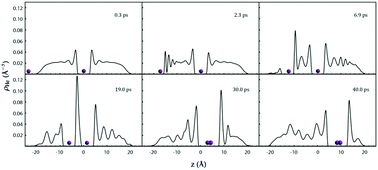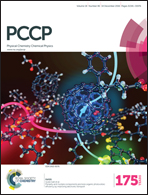Reaction dynamics inside superfluid helium nanodroplets: the formation of the Ne2 molecule from Ne + Ne@(4He)N†
Abstract
A hybrid time dependent quantum dynamics approach [DFT (helium) + quantum wave packet (dopant)] proposed by us (J. Chem. Theory Comput., 2015, 11, 890–906) has been extended to consider bimolecular type reactive processes involving a superfluid helium nanodroplet [A + B@4HeN → AB@4HeN′ + (N–N′)4He, with A and B being atomic species]; T = 0.37 K. This is probably the first theoretical attempt to study the reaction dynamics of this kind of process and in this initial investigation the total angular momentum has been taken as zero. The Ne + Ne@4HeN → Ne2(v = 0)@4HeN′ + (N–N′)4He reaction has been considered as the first application example and we have examined the influence of different nanodroplet sizes (N = 200, 500 and 1000) and initial velocities of the outer Ne atom (〈v0〉 = 120–1000 m s−1) on the dynamics. The inner Ne atom produces a greater reduction of the velocity of the outer Ne atom in comparison to what happens in the case of the capture of a Ne atom by a pure nanodroplet. The formation of the Ne2 molecule is a complex phenomenon related to the nature of the helium density waves produced and their reflection from the nanodroplet surface. Though the effective potential energy of Ne2 in the nanodroplet is very different from the gas phase case, the equilibrium Ne-Ne distance is only slightly reduced with respect to the gas phase value, and its vibrational wave function (v = 0) is only modified by 15% with respect to the gas phase one. Furthermore, the analysis of experiments on the capture of Ar, Kr and Xe with larger nanodroplets suggests that the number of evaporated helium atoms obtained here is too low for the initial velocities above 120 m s−1. This problem probably arises from the DFT description of the superfluid helium nanodroplet. We hope that this work will encourage researchers to investigate these very interesting processes about which we still know very little. Lastly, it is worth noting that the quantum treatment presented here can also be applied directly to the study of the photodissociation of an arbitrary diatomic molecule in a superfluid helium nanodroplet.


 Please wait while we load your content...
Please wait while we load your content...